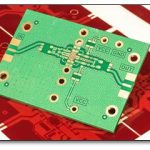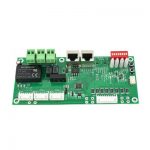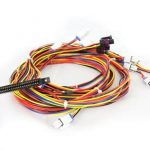Understanding PCB shelf life and Its Importance
Printed Circuit Board (PCB) shelf life refers to the period during which a PCB remains functional and reliable after its manufacture. It is a critical factor to consider when storing and using PCBs, as it directly impacts the performance and longevity of electronic devices. PCB shelf life is particularly important for double-sided PCBs, which undergo a first reflow process during assembly.
Factors Affecting PCB Shelf Life
Several factors influence the shelf life of a PCB, including:
- Storage conditions: Temperature, humidity, and exposure to contaminants can significantly impact PCB shelf life.
- PCB material: The type of substrate, copper thickness, and surface finish affect the durability and longevity of a PCB.
- Manufacturing process: The quality of the manufacturing process, including the first reflow, can influence the shelf life of a PCB.
The First Reflow Process and Its Impact on PCB Shelf Life
The first reflow process is a crucial step in the assembly of double-sided PCBs. During this process, the PCB is subjected to high temperatures to melt the solder paste and form a connection between the components and the board. The thermal stress induced during the first reflow can affect the PCB’s shelf life.
Factors Determining the Maximum PCB Shelf Life After First Reflow
Storage Conditions
Proper storage conditions are essential for maintaining the maximum shelf life of a double-sided PCB after the first reflow. The following storage guidelines should be followed:
- Temperature: PCBs should be stored in a temperature-controlled environment, ideally between 10°C and 30°C (50°F to 86°F).
- Humidity: The relative humidity should be maintained between 30% and 70% to prevent moisture absorption and corrosion.
- Packaging: PCBs should be stored in moisture-barrier bags (MBBs) with desiccants to protect them from moisture and contaminants.
| Storage Condition | Recommended Range |
|---|---|
| Temperature | 10°C to 30°C (50°F to 86°F) |
| Relative Humidity | 30% to 70% |
PCB Material and Surface Finish
The choice of PCB material and surface finish plays a significant role in determining the maximum shelf life after the first reflow. Some common PCB materials and their impact on shelf life include:
- FR-4: This is the most widely used PCB substrate material, offering good durability and a longer shelf life compared to other materials.
- High-Tg FR-4: This material has a higher glass transition temperature (Tg), providing better thermal stability and longer shelf life.
- Polyimide: Polyimide substrates offer excellent thermal stability and longer shelf life, making them suitable for high-reliability applications.
Surface finishes also contribute to the shelf life of a PCB. Some popular surface finishes and their impact on shelf life are:
| Surface Finish | Shelf Life Impact |
|---|---|
| HASL (Hot Air Solder Leveling) | Good shelf life, but prone to oxidation over time |
| ENIG (Electroless Nickel Immersion Gold) | Excellent shelf life, resistant to oxidation |
| OSP (Organic Solderability Preservative) | Limited shelf life, typically 6-12 months |
Manufacturing Process and Quality Control
The quality of the manufacturing process and the adherence to strict quality control measures significantly influence the maximum shelf life of a double-sided PCB after the first reflow. Some key aspects to consider include:
- Reflow profile optimization: The reflow profile should be carefully optimized to minimize thermal stress on the PCB and components.
- Solder paste selection: Using high-quality, temperature-stable solder paste can enhance the shelf life of the PCB.
- Cleanliness: Ensuring a clean manufacturing environment and proper cleaning of the PCB after the first reflow can prevent contamination and extend shelf life.
Maximizing PCB Shelf Life Through Proper Handling and Storage
To achieve the maximum shelf life for double-sided PCBs after the first reflow, proper handling and storage practices must be followed:
- ESD protection: Use electrostatic discharge (ESD) protective packaging and handling procedures to prevent damage to the PCB.
- Moisture management: Store PCBs in moisture-barrier bags (MBBs) with desiccants and moisture indicator cards (MICs) to monitor and control moisture levels.
- Periodic inspection: Regularly inspect stored PCBs for signs of oxidation, corrosion, or other damage.
- First-in, first-out (FIFO) inventory management: Use a FIFO inventory system to ensure that older PCBs are used first, minimizing the risk of exceeding the shelf life.

Shelf Life Estimation and Testing Methods
Estimating the shelf life of a double-sided PCB after the first reflow can be challenging, as it depends on various factors. However, some methods can help determine the shelf life:
- Accelerated aging tests: Subjecting PCBs to elevated temperatures and humidity levels can help estimate the shelf life under normal storage conditions.
- Solderability testing: Performing solderability tests, such as the wetting balance test or the dip-and-look method, can assess the solderability of the PCB over time.
- Ionic contamination testing: Measuring the ionic contamination levels on the PCB surface can indicate the potential for corrosion and reduced shelf life.
Frequently Asked Questions (FAQ)
1. What is the typical shelf life of a double-sided PCB after the first reflow?
The typical shelf life of a double-sided PCB after the first reflow can range from 12 to 24 months, depending on the storage conditions, PCB material, surface finish, and manufacturing quality. However, with proper storage and handling, the shelf life can be extended to 36 months or more.
2. Can I use a PCB that has exceeded its shelf life?
Using a PCB that has exceeded its shelf life is not recommended, as it may lead to solderability issues, reduced reliability, and potential device failures. It is always best to use PCBs within their specified shelf life to ensure optimal performance and reliability.
3. How can I extend the shelf life of my double-sided PCBs?
To extend the shelf life of your double-sided PCBs, follow these best practices:
- Store PCBs in a temperature-controlled environment with low humidity.
- Use moisture-barrier bags (MBBs) with desiccants to protect PCBs from moisture and contaminants.
- Implement ESD protective measures during handling and storage.
- Regularly inspect stored PCBs for signs of deterioration.
- Use a first-in, first-out (FIFO) inventory management system.
4. What should I do if I discover that my PCBs have exceeded their shelf life?
If you discover that your PCBs have exceeded their shelf life, it is recommended to perform solderability and ionic contamination tests to assess their condition. If the tests reveal significant deterioration, it is advisable to dispose of the PCBs and use fresh ones to ensure the best performance and reliability of your electronic devices.
5. Can I reflow a double-sided PCB multiple times without affecting its shelf life?
Reflowing a double-sided PCB multiple times can affect its shelf life, as each reflow cycle subjects the board to thermal stress. It is generally recommended to minimize the number of reflow cycles to preserve the PCB’s integrity and extend its shelf life. If multiple reflow cycles are necessary, ensure that the reflow profile is optimized to minimize thermal stress on the PCB and components.
Conclusion
Understanding and maximizing the shelf life of double-sided PCBs after the first reflow is crucial for ensuring the reliability and performance of electronic devices. By adhering to proper storage conditions, selecting appropriate PCB materials and surface finishes, maintaining a high-quality manufacturing process, and following best practices for handling and inventory management, you can achieve the maximum shelf life for your PCBs.
Remember to regularly assess the condition of your stored PCBs and use them within their specified shelf life to minimize the risk of device failures and maintain optimal performance.
Key Takeaways
- PCB shelf life is a critical factor affecting the performance and reliability of electronic devices.
- Double-sided PCBs are subject to thermal stress during the first reflow process, which can impact their shelf life.
- Proper storage conditions, PCB material selection, surface finish choice, and manufacturing quality control are essential for maximizing PCB shelf life.
- Implementing best practices for handling, storage, and inventory management can extend the shelf life of double-sided PCBs.
- Regular testing and inspection of stored PCBs can help assess their condition and ensure their suitability for use.
By understanding and addressing the factors that influence PCB shelf life, you can ensure the long-term reliability and performance of your double-sided PCBs, ultimately contributing to the success of your electronic projects.






Leave a Reply